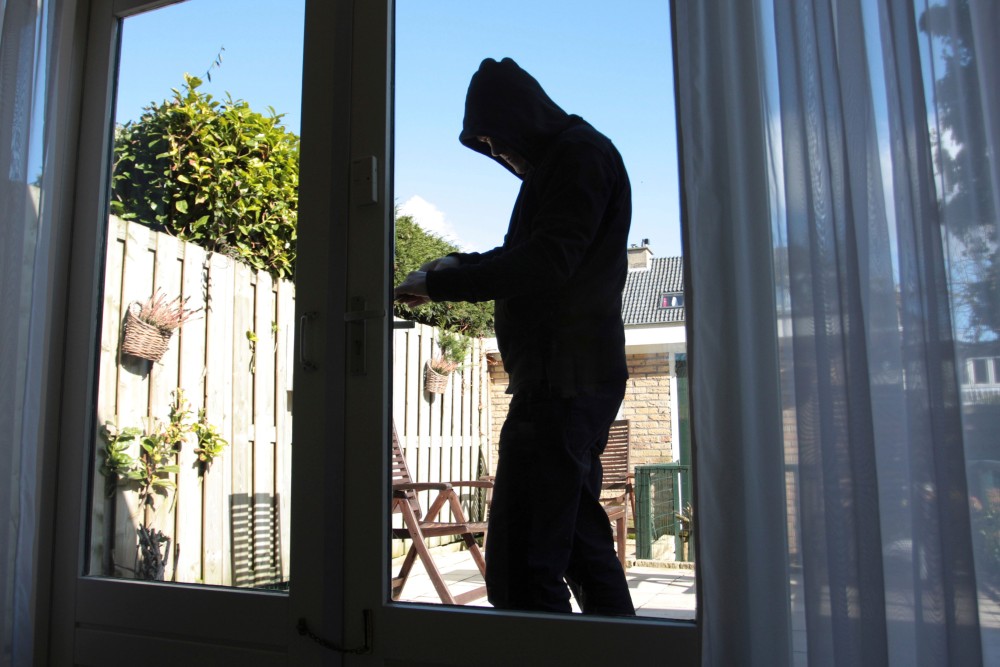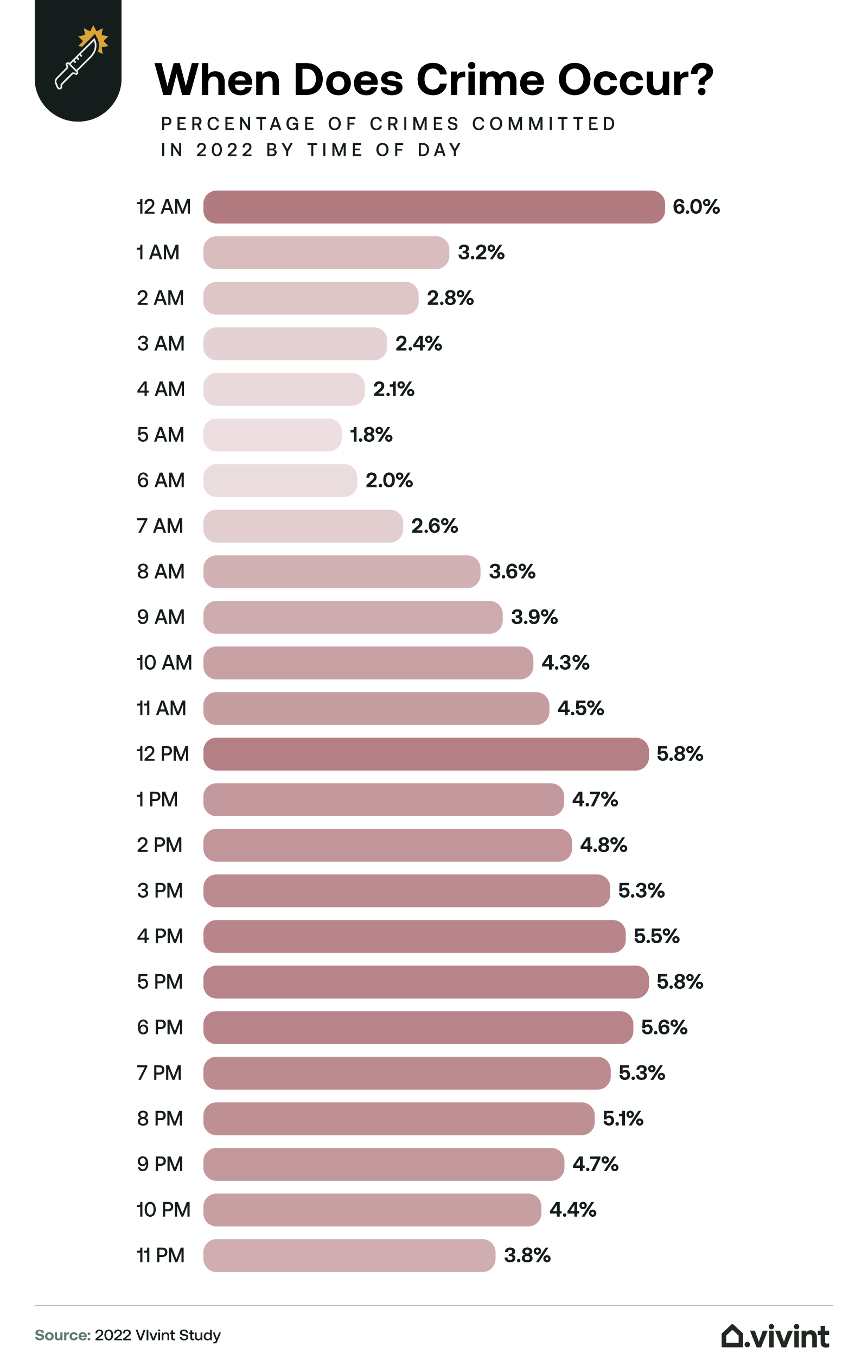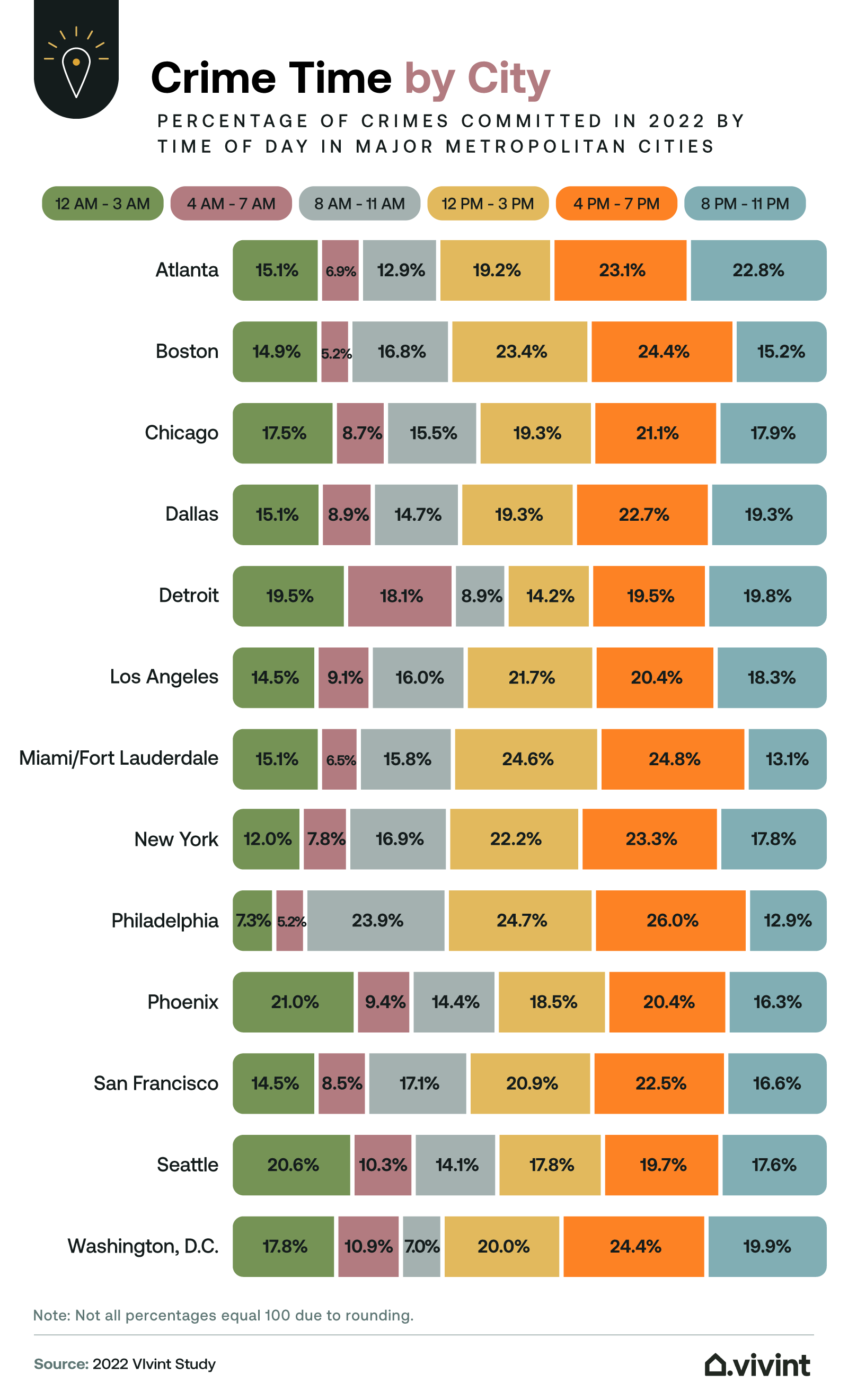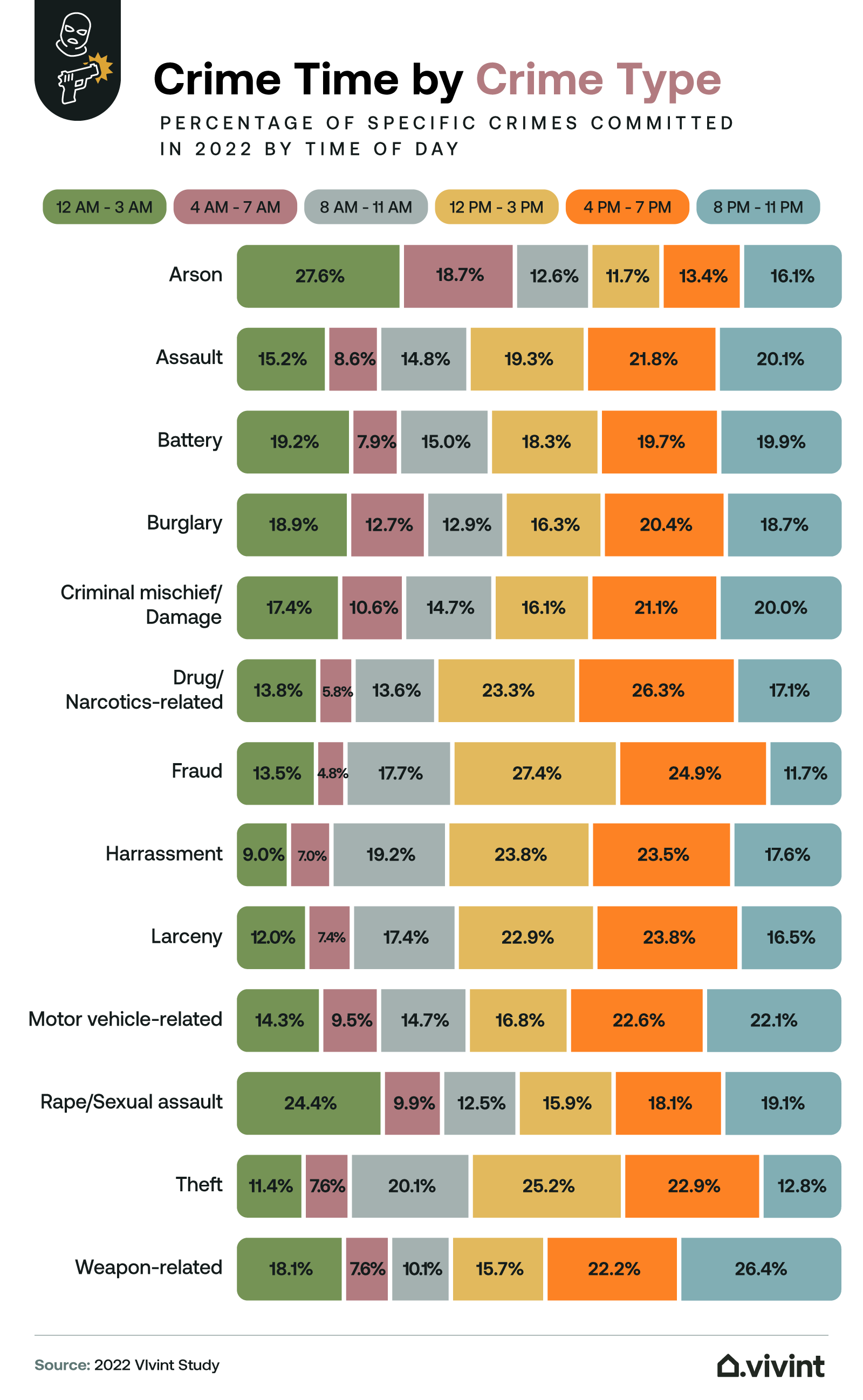
In popular media, criminal activity usually happens at night, and in real life, many people avoid being out or home alone at night. But does crime happen more often in the dark than in the daytime?
To find out, Vivint gathered public crime data from 2022 across 13 major metropolitan areas. We analyzed data from over 1.3 million crimes, including the type of crime, location, and what time of day each was committed. In this guide, we will break down the data to learn when criminal activity is at its highest and what you can do to help you and your family stay safe.
What time of day do crimes occur most?
Contrary to popular perception, we found that crime rates were not always the highest during nighttime hours. The following graph shows the percentage of crimes committed over a 24-hour period.

Although crime rates spiked at midnight (6.0%), they were nearly as high at noon (5.8%) and 5 p.m. (5.8%). Criminal activity was at its lowest from 1 a.m. to 7 a.m., with rates ranging from 1.8% to 3.2% during these hours.
Crime rates steadily rose from 8 a.m. to 5 p.m., spiking at noon (5.8%), then steadily falling through 11 p.m. The most standout statistic from this dataset was the drastic spike in criminal activity at midnight. Crime rates at 11 p.m. were on the low end at 3.8%, then spiked up to 6.0% at midnight, only to drop to 3.2% at 1 a.m.
Most popular time for crime in metropolitan areas
After looking at crime statistics by the hour, we further analyzed the dataset by city. The graph below shows the crime rates for each city during six time periods throughout the day.

Most metropolitan areas saw high rates of criminal activity in the afternoon through evening hours, with crime rates dropping during the night. However, there were a few exceptions. These are the most active hours for crime in each city and the percent of criminal activity that took place during those peak times:
- Atlanta: 4 p.m. to 7 p.m. (23.1%)
- Boston: 4 p.m. to 7 p.m. (24.4%)
- Chicago: 4 p.m. to 7 p.m. (21.1%)
- Dallas: 4 p.m. to 7 p.m. (22.7%)
- Detroit: 8 p.m. to 11 p.m. (19.8%)
- Los Angeles: Noon to 3 p.m. (21.7%)
- Miami/Fort Lauderdale: 4 p.m. to 7 p.m. (24.8%)
- New York: 4 p.m. to 7 p.m. (23.3%)
- Philadelphia: 4 p.m. to 7 p.m. (26.0%)
- Phoenix: Midnight to 3 a.m. (21.0%)
- San Francisco: 4 p.m. to 7 p.m. (22.5%)
- Seattle: Midnight to 3 a.m. (20.6%)
- Washington, D.C.: 4 p.m. to 7 p.m. (24.4%)
Nine of the 13 metropolitan areas experienced the most crime incidents from 4-7 p.m. Los Angeles crime peaked during midday, from noon to 3 p.m., while the three remaining cities saw increased crime rates late at night. Crime rates in Detroit were highest from 8-11 p.m., and its only significant break from criminal activity took place from 8-11 a.m. Phoenix and Seattle both spiked in the middle of the night, from midnight to 3 a.m.
Philadelphia’s criminal activity, however, was high during all daytime and early evening hours from 8 a.m. to 7 p.m., accounting for 74.6% of the city’s crime. Crime rates in Philly dropped by 66% after 8 p.m., and it had the least incident reports between 4-7 a.m., when many people are usually home asleep or just waking up to start their day.
Overall, crime in metropolitan areas was generally lowest in the late night and early morning hours, especially between 4-7 a.m.
When 13 types of crime are likely to occur
Just as criminal activity in cities varied throughout the day, so did specific types of crime. The graph below shows when each of the 13 types of crimes we measured was most often committed.

Aligning with the high criminal activity hours of the metropolitan areas, most types of crime reached their peak hours between 4-7 p.m. But there were, of course, a few exceptions. Below are the most active hours for each type of crime and the percentage of crimes that took place during those peak hours:
- Arson: Midnight to 3 a.m. (27.6%)
- Assault: 4 p.m. to 7 p.m. (21.8%)
- Battery: 8 p.m. to 11 p.m. (19.9%)
- Burglary: 4 p.m. to 7 p.m. (20.4%)
- Criminal mischief/damage: 4 p.m. to 7 p.m. (21.1%)
- Drug/narcotics-related: 4 p.m. to 7 p.m. (26.3%)
- Fraud: Noon to 3 p.m. (27.4%)
- Harassment: Noon to 3 p.m. (23.8%)
- Larceny: 4 p.m. to 7 p.m. (23.8%)
- Motor vehicle-related: 4 p.m. to 7 p.m. (22.6%)
- Rape/sexual assault: Midnight to 3 a.m. (24.4%)
- Theft: Noon to 3 p.m. (25.2%)
- Weapons-related: 8 p.m. to 11 p.m. (26.4%)
What type of crime is more likely to happen during the day?
Most crimes occurred between noon and 7 p.m., when many people are out and about. Assault, burglary, criminal mischief, drug crimes, fraud, harassment, larceny, car crimes, and theft were at their highest during these hours. Arson, battery, sexual assaults, and weapons-related crimes most often happened later at night.
Interestingly, while larceny and theft peaked from noon to 7 p.m. (46.7% and 48.1%, respectively), burglary spiked from 4 p.m. to 3 a.m. Although used interchangeably, larceny and theft differ from burglary. Larceny and theft refer to the stealing of property, while burglary involves forcible entry into a property to commit a crime that threatens the safety of people or their belongings. While theft can mean stealing any type of property, larceny is a type of theft that involves tangible items.
A misdemeanor property crime, most larceny and theft occurred during daytime hours when many people would be at work. The only exception was grand larceny motor vehicle theft, which rose to 44.7% between 4-11 p.m., when people might be out using public parking for entertainment, granting criminals easier access.
Burglary, on the other hand, often occurred at other times. This type of crime could include breaking into a building to commit not only larceny or theft, but potentially vandalism, assault, rape, murder, or other crimes. Burglary is considered a violent crime, and most violent crimes occur at night, which explains its deviation from the daytime crime incident hours of larceny and theft.
Which type of crime is more likely to happen at night?
While most crimes occur during daytime hours, violent crimes mostly happen at night. Burglary, rape/sexual assault, and murder are all violent crimes. Battery and assault can be considered misdemeanors or felony violent crimes, depending on the severity of the crime, with aggravated assault and severe battery being violent crimes.
Of violent crimes, battery, burglary, and rape all peaked during late night and early morning hours, with almost one-quarter of rape and sexual assault crimes committed between midnight and 3 a.m. Battery and assault also peaked during daytime hours, though further data collection would be needed to distinguish between simple assault/battery crimes and aggravated assault/battery crimes.
Arson was also prevalent during late night and early morning hours, with almost 28% of arson committed between midnight and 3 a.m.
Six ways to prevent crime around your home
No matter where you live or what time crime peaks in your area, implementing certain practices and devices can help keep you and your family members safe. The following are six ways you can improve safety and protect your home from serious crimes.
Keep all doors and windows locked
Forcible entry into a home does not always require force. Most criminals are opportunists and will choose an unlocked home or vehicle over a home that requires broken windows or picked locks. Always keep windows locked when no one is home, and keep doors locked at all times.
Consider smart locks
To prevent yourself from getting locked out of the house, many people hide a key somewhere outside their home. Unfortunately, burglars are aware of this and know the most common places keys are hidden. Upgrading outside doors to smart locks eliminates the need for keys. Smart lock codes are created by you and can be changed often to ensure security. They also prevent you and your family members from getting locked out.
Invest in smart lighting
A dark house makes theft much easier for criminals. Using smart lighting both inside and outside your home lets you control your lights from anywhere, even when you’re on vacation. Having active lights can fool would-be intruders into thinking someone is home even when you’re not, encouraging them to move on to an easier, darker target.
Keep your garage closed
Garages can be a weak point in home security. Inside doors leading to the garage often have little to no security, and it’s easy to forget to close the garage door. Using a smart garage door allows you to control and monitor yours from anywhere, so you can always ensure the garage is closed and secure.
For added security, you can install a Vivint Car Guard in your car that will automatically close the garage door when you leave. It can also protect your vehicle from the increasing car thefts reported by the Federal Bureau of Investigation (FBI). The Vivint Car Guard notifies you if your car is disturbed and allows you to track your car by GPS.
Install a security system
The presence of a home security system is one of the single biggest detractors for would-be burglars. Installing a monitored security system allows you to be in control of your home’s security and provides reassurance that someone is always looking out for the safety of your home. When security systems are triggered, they provide a quick connection to local law enforcement and emergency services.
Ensure security cameras aren’t blocked
Wherever you place security cameras, make sure they have clear views of the area. Check camera views regularly in case storms, animals, or people knock the camera off-angle. Also, check the signal connection often to make sure your camera is on and recording.
Find peace of mind with a smart home security system
Police departments and law enforcement agencies work hard to deter crime and ensure criminal justice when a crime is committed, but criminals are still a threat. Property crimes, motor vehicle theft, violent crimes, and other criminal activity happen in every city, every day. While the FBI, U.S. Department of Justice, and other government agencies work to prevent crimes on the national level, it’s important for individuals to understand crime statistics and crime prevention.
Vivint’s home security systems, smart home tools, and monitoring services can help you take control of your safety and protect your home and loved ones. Invest in your family’s safety and find peace of mind with Vivint by calling us today at 855.822.1220.


